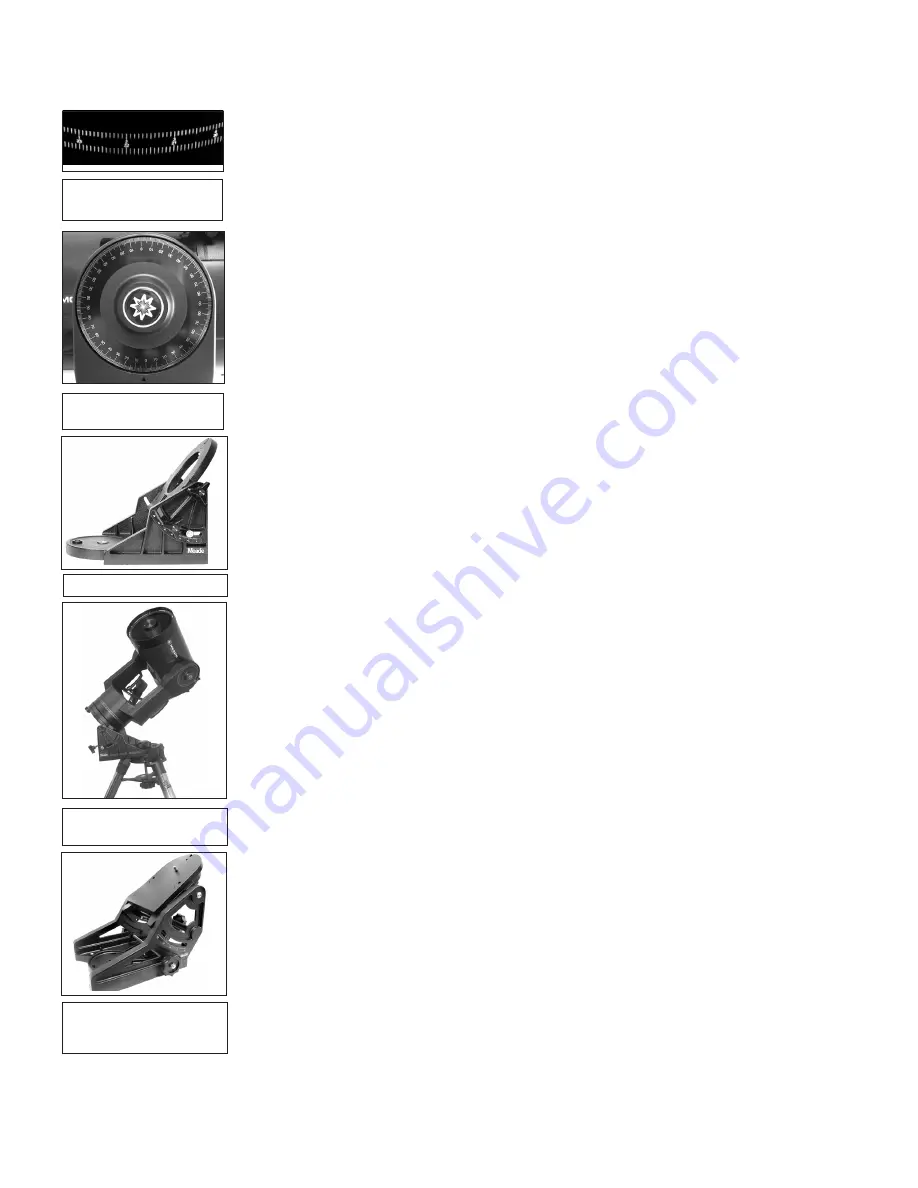
51
Note that the R.A. circle is double-indexed (i.e., there are two series of numbers running in
opposite directions around the circumference of the R.A. circle). The upper series of numbers
(increasing counterclockwise) applies to observers located in the Earth’s Northern Hemisphere;
the lower series of numbers (increasing clockwise) applies to observers located in the Earth’s
Southern Hemisphere.
To use the setting circles to locate an object not easily found by direct visual
observation:
With the telescope aligned to the Celestial Pole, first look up the celestial coordinates (R.A. and
Dec.) of the object in a star atlas. Then loosen the R.A. lock and turn the telescope to read the
correct R.A. of the desired object; lock the R.A. lock onto the object. Next, turn the telescope in
Declination to read the correct Declination of the object. If the procedure has been followed
carefully, and if the telescope was well-aligned with the pole, the desired object should now be
in the telescopic field of a low-power eyepiece.
If you do not immediately see the object you are seeking, try searching the adjacent sky area.
Keep in mind that, with the 26mm eyepiece, the field of view of the LX90 is about 0.5°. Because
of its much wider field, the viewfinder may be of significant assistance in locating and centering
objects, after the setting circles have been used to locate the approximate position of the object.
Pinpoint application of the setting circles requires that the telescope be precisely aligned with
the pole. See
LINING UP WITH THE CELESTIAL POLE
, below.
EQUATORIAL WEDGE
An optional equatorial wedge allows a more precise Polar alignment. Polar alignment allows
you to take longer exposure photographs with your LX90.
The LX90 requires an adapter to attach the equatorial wedge to the tripod. See the instruction
sheet supplied with the wedge for installation.
Equatorial Wedge
The equatorial wedge permits use in an astronomical, or “equatorial,” mode. The wedge fits onto
the field tripod.
NOTE:
The Meade equatorial wedge is designed solely for use in conjunction with
the Meade field tripod. The wedge should never be used without the field tripod
(e.g., by placing the wedge alone on a table top and then mounting the telescope
on the wedge – the wedge may become seriously imbalanced, to the point where
the telescope may actually tip over.
Included features:
•
Attachment of the wedge to the field tripod by means of only one manual knob.
•
Quick azimuth adjustment by loosening the manual knob as described above.
•
Bubble level for rapid tripod/wedge leveling.
•
Etched latitude scale for fast adjustment of the latitude angle.
Lining Up with the Celestial Pole
Objects in the sky appear to revolve around the celestial pole. (Actually, celestial objects are
essentially “fixed”. Their apparent motion is caused by the Earth’s rotation). During any 24 hour
period, stars make one complete revolution about the pole, making concentric circles with the
pole at the center. By lining up the telescope’s polar axis with the North Celestial Pole (or for
observers located in Earth’s Southern Hemisphere, with the South Celestial Pole),
astronomical objects may be followed, or tracked, simply by moving the telescope about one
axis, the polar axis. This tracking may be accomplished automatically with the
LX90
electric
motor drive.
If the telescope is reasonably well aligned with the pole, very little use of the telescope’s
Declination slow motion control is necessary. Virtually all of the required telescope tracking will
be in Right Ascension. (If the telescope were perfectly aligned with the pole, no Declination
tracking of celestial objects would be required.) For the purposes of casual telescopic
observations, lining up the telescope’s polar axis to within a degree or two of the pole is more
than sufficient: With this level of pointing accuracy, the telescope’s motor drive will track
accurately and keep objects in the telescopic field of view for perhaps 20 to 30 minutes.
Fig. 29: Section of Right
Ascension Setting Circle.
Fig. 30: Section of
Declination Setting Circle.
Fig. 31a: Equatorial Wedge.
Fig. 31c: The Ultrawedge is
available for the 10" and 12"
models.
Fig. 31b: LX90 mounted on
an equatorial wedge.
Summary of Contents for LX90-ACF Advanced Coma-Free
Page 57: ...OBSERVATION LOG 57...
Page 58: ...58 OBSERVATION LOG...
Page 59: ...59 OBSERVATION LOG...






































